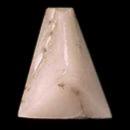|
|
||||||||||||||||
|
||||||||||||||||
|
||||||
|
|
|
|
Eucryptite
|
|
| | |
| Discovered in 1880; IMA status: Valid (pre-IMA; Grandfathered) | ||
|
| ||
|
Chemistry |
|
|
| |
|
LiAlSiO4 | |
|
|
Lithium Aluminum Silicate |
|
Molecular Weight: |
126.01 gm |
|
Composition: |
Lithium |
5.51 % |
Li |
11.86 % |
Li2O |
|
|
Aluminum |
21.41 % |
Al |
40.46 % |
Al2O3 |
|
|
Silicon |
22.29 % |
Si |
47.68 % |
SiO2 |
|
|
Oxygen |
50.79 % |
O |
|
|
|
|
|
100.00 % |
|
100.00 % |
= TOTAL OXIDE |
|
|
|
||||
|
Classification |
|
|
| |
|
Silicates (Germanates) | |
|
8/A.01-30 | |
|
|
9 : SILICATES (Germanates)
|
|
Related to: |
Phenakite Group. |
|
Members of Group: |
Phenakite Group: Eucryptite, Phenakite, Willemite |
|
Varieties: |
None |
|
Synonyms: |
ICSD 30982, Lithionnephelin, PDF 14-667 |
|
|
|
|
Crystal Data |
|
|
|
|
|
Rare euhedral crystals, to 3 cm; common forms are {1010}, {1120} and {0001}. In coarse crystalline aggregates and massive. |
|
|
None |
|
|
|
|
|
Physical Properties |
|
|
|
|
|
Poor/indistinct on {1010} and {0001} |
|
|
Irregular/Uneven, Conchoidal |
|
|
Brittle |
|
|
6.5 |
|
|
2.657 - 2.666 (g/cm3) |
|
|
Fluoresces pink to magenta-red or orangish-red under SW UV |
|
|
Not Radioactive |
|
|
|
|
|
Optical Properties |
|
|
|
|
|
Colorless, White, Tan, Gray |
|
|
Transparent to translucent |
|
|
Vitreous |
|
|
1.570 - 1.587 Uniaxial ( + ) |
|
|
0.0130 |
|
|
None |
|
|
None |
|
|
|
|
|
Occurances |
|
|
|
|
|
Geological Setting: |
In lithium-rich pegmatites, often as graphic intergrowths with albite derived from alteration of spodumene. |
|
Common Associations: |
Albite, Amblygonite, Lepidolite, Petalite, Quartz, Spodumene |
|
Common Impurities: |
Na, K |
|
Type Locality: |
Abija N. Fillow Quarry (Branchville Quarry), Branchville, Redding, Fairfield Co., Connecticut, USA |
|
Year Discovered: |
1880 |
|
View mineral photos: | |
|
|
|
|
Unusual Gem Categories |
|
|
|
|
|
|
Fluorescent Gems |
|
|
|
|
More Information |
|
|
|
|
|
| |
|
|
|
|
Eucryptite was named in 1880 by American mineralogists George J. Brush (1831-1912) and Edward S. Dana (1849-1935) from the Greek words for well and concealed, in reference to its occurrence as intimate intergrowths with Albite. Eucryptite
can be found in the USA, from Branchville, Fairfield
County, Connecticut; Center Strafford, Strafford County,
New Hampshire; in the Harding pegmatite, Dixon, Taos
County, New Mexico; in the Midnight Owl pegmatite, Maricopa
County, Arizona; and in the Foote mine, Kings Mountain,
Cleveland County, North Carolina. From the Tanco pegmatite,
Bernic Lake, Manitoba, and near Nakina, Ontario, Canada.
In Zimbabwe, large amounts at Bikita, with many other
minor localities. From the Haapaluoma quarry, near Peräseinäjoki,
Finland. |
|
|
We
have not photographed our Eucryptite
gems yet. Please
check back soon. |
